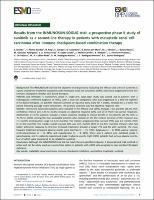| dc.contributor | Vall d'Hebron Barcelona Hospital Campus |
| dc.contributor.author | Alonso-Gordoa, Teresa |
| dc.contributor.author | Reig Torras, Oscar |
| dc.contributor.author | Esteban, Emilio |
| dc.contributor.author | Castellano, D. |
| dc.contributor.author | Garcia del Muro, Xavier |
| dc.contributor.author | González Rodríguez, Macarena |
| dc.contributor.author | Grande, Enrique |
| dc.date.accessioned | 2023-06-06T08:24:52Z |
| dc.date.available | 2023-06-06T08:24:52Z |
| dc.date.issued | 2022-04 |
| dc.identifier.citation | Grande E, Alonso-Gordoa T, Reig O, Esteban E, Castellano D, Garcia-del-Muro X, et al. Results from the INMUNOSUN-SOGUG trial: a prospective phase II study of sunitinib as a second-line therapy in patients with metastatic renal cell carcinoma after immune checkpoint-based combination therapy. ESMO Open. 2022 Apr;7(2):100463. |
| dc.identifier.issn | 2059-7029 |
| dc.identifier.uri | https://hdl.handle.net/11351/9666 |
| dc.description | Inhibidors del punt de control immunitari; Carcinoma renal metastàtic; Tractament de segona línia |
| dc.description.sponsorship | This work was supported by Pfizer, S.L.U. (Madrid, Spain). Pfizer, S.L.U. provided an unrestricted research grant with drug funding and drug supply to conduct the study (no grant number). |
| dc.language.iso | eng |
| dc.publisher | Elsevier |
| dc.relation.ispartofseries | ESMO Open;7(2) |
| dc.rights | Attribution-NonCommercial-NoDerivatives 4.0 International |
| dc.rights.uri | http://creativecommons.org/licenses/by-nc-nd/4.0/ |
| dc.source | Scientia |
| dc.subject | Avaluació de resultats (Assistència sanitària) |
| dc.subject | Ronyons - Càncer - Tractamemt |
| dc.subject.mesh | Carcinoma, Renal Cell |
| dc.subject.mesh | /drug therapy |
| dc.subject.mesh | Indoles |
| dc.subject.mesh | /therapeutic use |
| dc.subject.mesh | Treatment Outcome |
| dc.title | Results from the INMUNOSUN-SOGUG trial: a prospective phase II study of sunitinib as a second-line therapy in patients with metastatic renal cell carcinoma after immune checkpoint-based combination therapy |
| dc.type | info:eu-repo/semantics/article |
| dc.identifier.doi | 10.1016/j.esmoop.2022.100463 |
| dc.subject.decs | carcinoma de células renales |
| dc.subject.decs | /farmacoterapia |
| dc.subject.decs | indoles |
| dc.subject.decs | /uso terapéutico |
| dc.subject.decs | resultado del tratamiento |
| dc.relation.publishversion | https://doi.org/10.1016/j.esmoop.2022.100463 |
| dc.type.version | info:eu-repo/semantics/publishedVersion |
| dc.audience | Professionals |
| dc.contributor.organismes | Institut Català de la Salut |
| dc.contributor.authoraffiliation | [Grande E] Medical Oncology, MD Anderson Cancer Center Madrid, Madrid, Spain. [Alonso-Gordoa T] Medical Oncology, Hospital Universitario Ramón y Cajal, Madrid, Spain. [Reig O] Medical Oncology, Hospital Clinic and Translational Genomics and Targeted Therapies in Solid Tumors Group, August Pi I Sunyer Biomedical Research Institute (IDIBAPS), Barcelona, Spain. [Esteban E] Medical Oncology, Hospital Universitario Central de Asturias, Oviedo, Spain. [Castellano D] Medical Oncology, Hospital Universitario 12 de Octubre, Madrid, Spain. [Garcia-Del-Muro X] Medical Oncology, Institut Català d’Oncologia (ICO Bellvitge) Idibell, University of Barcelona, Barcelona, Spain. [González Rodríguez M] Vall d’Hebron Institute of Oncology (VHIO), Barcelona, Spain. Servei d’Oncologia Mèdica, Vall d’Hebron Hospital Universitari, Barcelona, Spain |
| dc.identifier.pmid | 35405437 |
| dc.identifier.wos | 000797892800020 |
| dc.rights.accessrights | info:eu-repo/semantics/openAccess |

 Àrea privada
Àrea privada Contacte
Contacte







